Overview
The Temple of Olympian Zeus at Akragas, or the Olympieion, is renowned for its extraordinary properties of its size and the Atlantes that support it. What makes it even more mystical is that all that is left of it is the foundation and 2 of the Atlantes! Without having the temple around in modernity, it becomes a very enigmatic monument that relies on antiquity to tell its story.
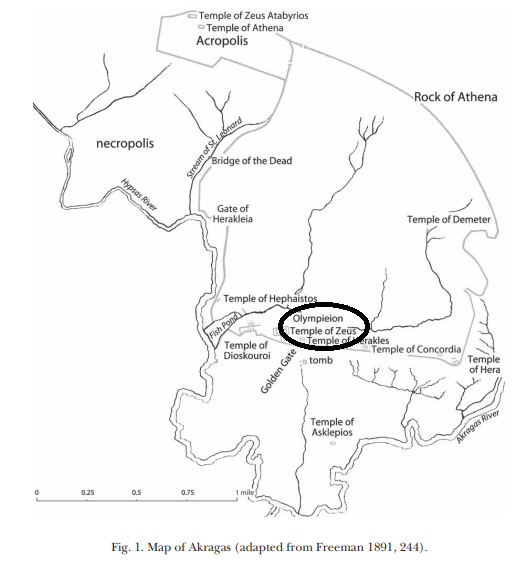
The unfinished Temple of Olympian Zeus was constructed around 480 BC. It was located in the middle of the city to show the significance of this architectural feat. It was constructed to show a sign of gratitude towards Zeus for helping the Agrigentines win over the Carthaginians.
The temple was symbolically built to celebrate Theron’s victory at the Battle of Himera and to one-up his rival’s temple. Temple G at Selinus was formerly the biggest temple in Sicily. Theron had been to war with Selinus, and the Battle of Himera was a perfect excuse to build a bigger temple.
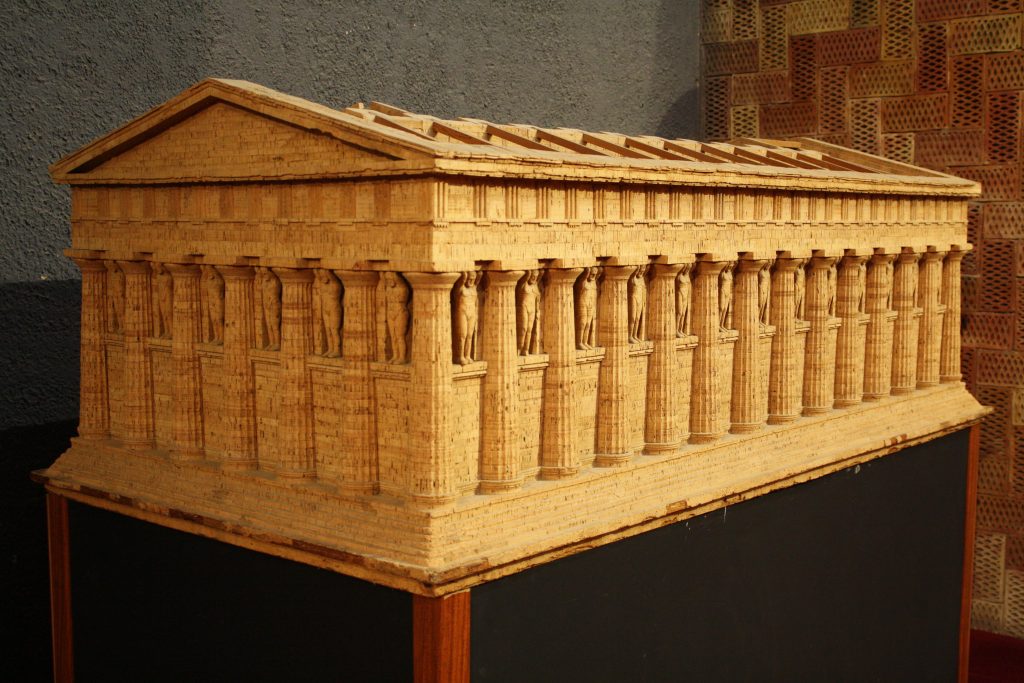
Details
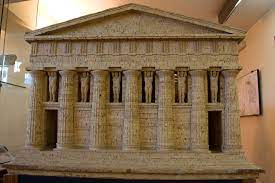
This is a reconstruction of the Olympieion, found at the Archaeological Museum of Agrigento.
The temple has supposed measurements of 340 X 160 ft with a height of 120 ft. These measurements come from the account of Diodorus and could be skewed due to rounding or differences in measurement systems of the time. The temple has 7 columns across the front and 14 columns across the side. In between each column is an Atlante.
This is a mock-up of the temple’s floor plan. The inside is divided into 3 spaces, with rows of piers made of small blocks and intervening screens dividing them. Two cross walls ran through the temple. Today, only 3 of these piers have been preserved above the floor level—others can be found at the foundation.
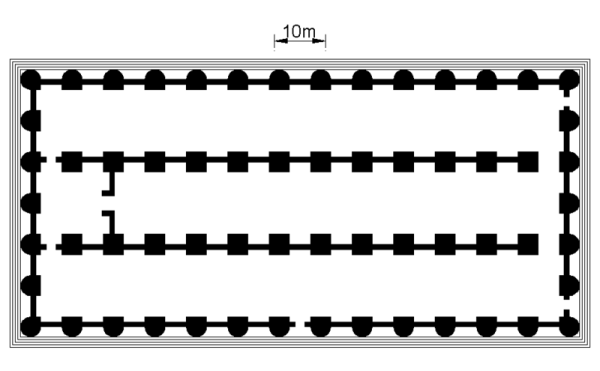
Ionic vs Doric
Ionic
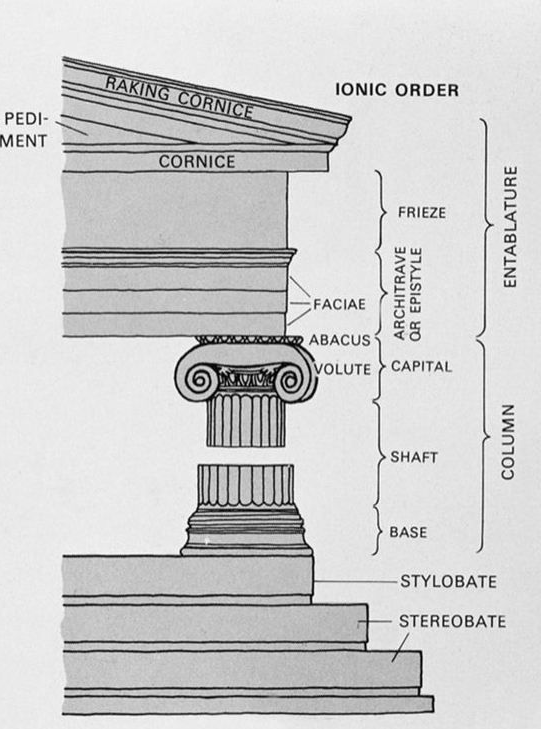
The Ionic order is one of the classical orders of ancient Greek architecture, starting around 600 BC. It is characterized by its distinctive capitals and a base supporting the columns. The main noticeable difference with Ionic temples is their columns. Ionic columns tend to be taller and more slender than Doric columns. This creates a more graceful aesthetic. Ionic architecture is known for its ornamental details and decorative elements. The most decorative piece would be the voluted capitals. It is the most recognizable feature. Ionic columns have volutes, which are scroll-like ornaments that are attached to the capital.
Doric
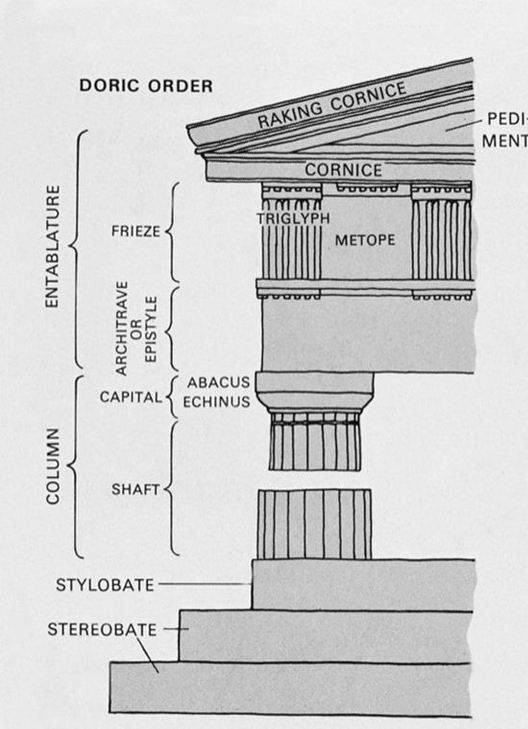
Doric is the second classical order of ancient Greek architecture, starting around 700 BC. The main distinctions of Doric architecture are its capitals, base, and columns. The Capitals are plain; there are no volutes or decorations. The columns are fluted, which means they have shallow vertical grooves running up the length of the column. The columns are solid and wide. Doric columns typically did not have a distinct base. Instead, they often rest directly on the stylobate, which is the uppermost step of the temple. This creates a sense of solidity and stability, a key attribute of Doric architecture.
Atlantes
The Atlantes are the male structural supports between each column of the temple. They are approximately 7.5 meters tall. These are the main novelty of the structure, as they are potentially the first of their kind.
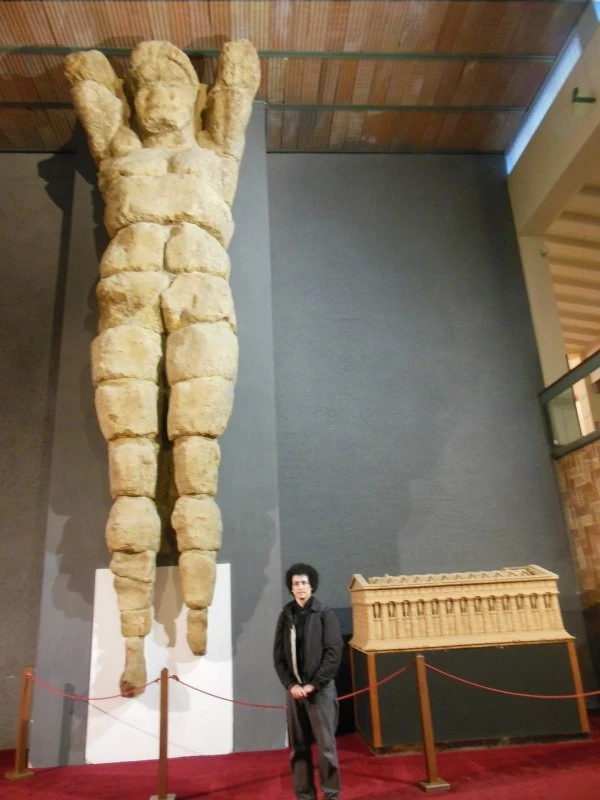
These monumental structures represent Atlas, the Titan. In Greek myth, Atlas revolted against the gods, and as a result, Olympian Zeus condemned him to an eternity of carrying the heavens upon his shoulders. The Atlantes statues mimic this, carrying Olympian Zeus’ temple on their backs. This design was intentional to create a parallel between Theron and Zeus—Theron would silence barbarians, as he did with the Carthaginians during the Battle of Himera, and keep the Greeks in their powerful position. This can also be seen as a threat to opposition. Those who oppose Theron will end up just like Atlas!
Architecture
There is a minimal amount of evidence to work from to learn about what the temple actually looked like due to its current state, but we can draw several conclusions from what we do know.
Basics
The temple had a large basement with a five-step crepidoma, as opposed to the normal three-step. The crepidoma is the platform upon which the temple is erected, and it typically forms a series of steps. The additional two steps to the crepidoma just reemphasize how vast the temple truly was.
The inside of the temple was divided into 3 spaces. The rows of piers dividing them were made of small blocks with intervening screen walls and two cross walls. However, only 3 of these piers have been preserved above the floor level (others are found at the foundation).
The Stylobate
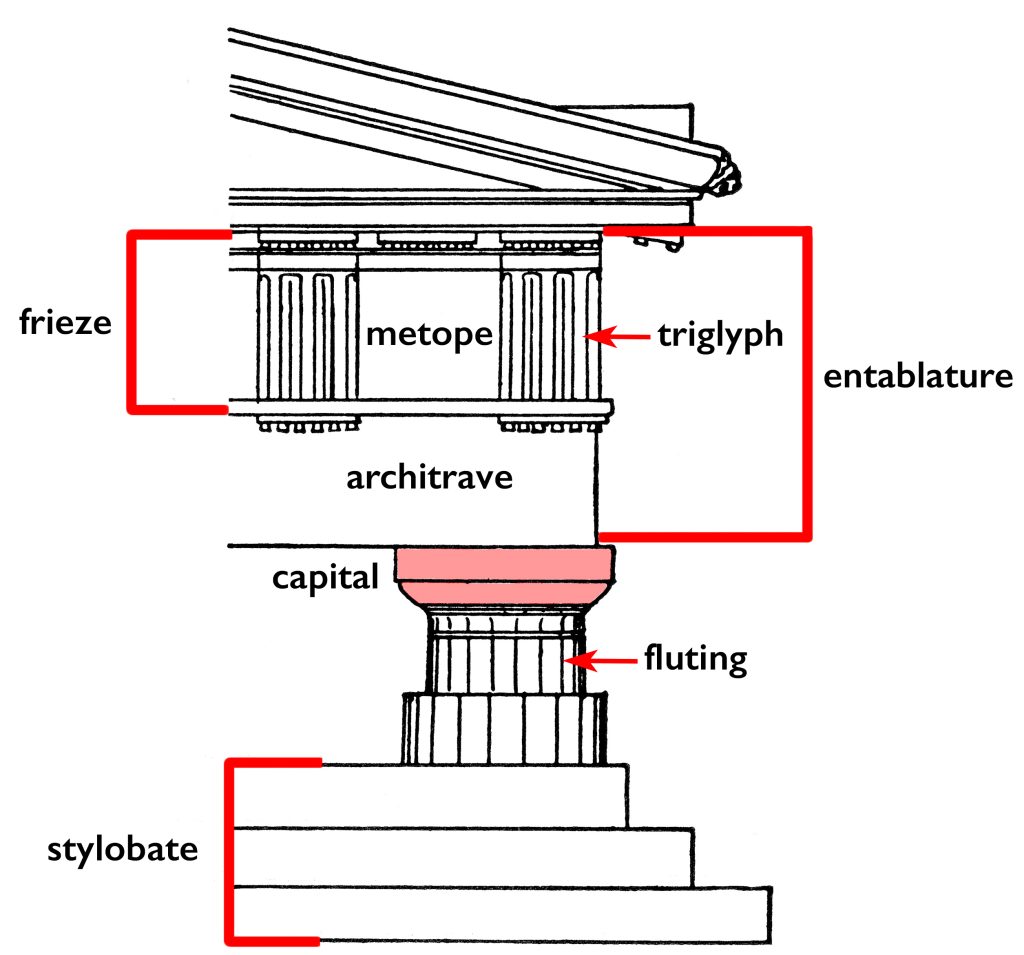
The stylobate is the base that supports a row of columns in the temple. By using the measurements, we can determine that the temple does not originate from a neighboring one, Temple G at Selinus.
If the measurements Diodorus gives us (340 ft length, 160 ft width, 120 ft height) are correct, we can conclude that it is a coincidence that Temple G and the Olympieion have the same length, as the measurements for the Olympieion are so because of internal considerations. The builders adjusted the interaxial measurements rather than the stylobate.
Excavations
1926 – P. Marconi and G. Ricci
Marconi and Ricci found fragments of terracotta roof tiles in the South Hall. These tiles were intended to go along the base of a pitched roof. This pitched roof indicates that this part of the building had a roof with 2 slopes that must have run east to west (along the long axis of the temple). The same is true for the North Hall as the South Hall. The inner slope of the roof was inclined toward the center space of the temple, which some believe was meant to be an open space towards the sky.
1940 – G. Ricci
Unfortunately, this excavation was never published. Ricci found the foundation of the pronaos wall between a second pair of piers. The pronaos is the vestibule in front of the entrance to the Greek temple, enclosed by columns and a projection of the side and front wall(s) of the cella. Ricci also found that piers S2 and S3 were hollow and had shafts that continued into the foundation below the temple. The depths of these shafts are more than 6 meters below floor level. So, not only was the temple gargantuan above ground, but it extended drastically underground as well.
Purpose
Battle of Himera 480 BC
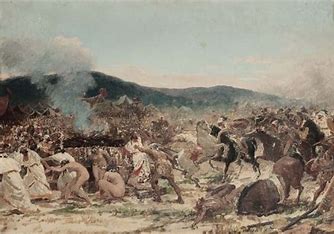
The Battle of Himera was a significant conflict fought in 480 BC between the Greek city-state of Syracuse, led by Gelon, and the Carthaginian forces under Hamilcar. It took place near the city of Himera in Sicily. Gelon, along with the aid of the Greek city-states of Gela and Akragas, defeated the Carthaginians. This victory secured Greek dominance in Sicily for a considerable period and prevented Carthage from expanding its influence further into the island.
Theron
Theron was a notable figure in ancient Sicilian history, particularly known as a tyrant of the city-state of Akragas during the 6th century BC. Theron is perhaps best remembered for his role in the Battle of Himera in 480 BC, where he allied with the Greek city-state of Syracuse, led by Gelon, to defeat the invading Carthaginian forces. This victory solidified his position and brought him considerable prestige throughout the Greek world. Theron’s rule was characterized by prosperity and cultural development in Akragas, as evidenced by the magnificent architectural projects undertaken during his reign, the most notable being the Temple of Olympian Zeus. Theron, like all other tyrants of the time, was obsessed with winning the chariot games. He got his victory in 476 BC and had Pindar write two odes commemorating his victory. Theron’s contributions to Sicilian politics and the Greek struggle against Carthaginian expansion left a lasting impact on the region’s history.
“Songs, rulers of the lyre, what god, what hero, what man shall we celebrate? Indeed, Pisa belongs to Zeus; and Heracles established the Olympic festival, as the finest trophy of battle; and Theron must be proclaimed because of his victorious four-horse chariot.”
Pindar, Olympian 2.1-6
Religious
Zeus was worshipped at the site. The temple emphasized Zeus’s kingship over the other Hellenic gods and made reference to the Panhellenic festival of Zeus at Olympia. Theron choosing Zeus was not only for the religious significance, but also played an integral part of Greek culture and identity. Choosing to worship Zeus after a major victory, like Himera, would have reinforced a connection back to Greece for cultural pride and solidarity.
Texts
Literary sources for the monument are scarce, but Diodorus thoroughly discusses the appearance of the ancient temple.

Diodorus Siculus, born in Sicily, was an ancient Greek historian who wrote in the first century BC. He wrote the Library of History, a continuous account of history beginning with myths of Greek and non-Greek tribes and ending with the Gallic Wars.
In his 13th book, chapter 82, he details the appearance of the monument:
“Of the other sacred buildings some have been burned and others completely destroyed because of the many times the city has been taken in war, but the completion of the temple of Zeus, which was ready to receive its roof, was prevented by the war; and after the war, since the city had been completely destroyed, never in the subsequent years did the Acragantini find themselves able to finish their buildings. The temple has a length of three hundred and forty feet, a width of sixty, and a height of one hundred and twenty not including the foundation. And being as it is the largest temple in Sicily, it may not unreasonably be compared, so far as magnitude of its substructure is concerned, with the temples outside of Sicily; for even though, as it turned out, the design could not be carried out, the scale of the undertaking at any rate is clear. And though all other men build their temples either with walls forming the sides or with rows of columns, thrown enclosing their sanctuaries, this temple combines both these plans; for the columns were built in with the walls, the part extending outside the temple being rounded and that within square; and the circumference of the outer part of the column which extends from the wall is twenty feet and the body of a man may be contained in the fluting, while that of the inner part is twelve feet. The porticoes were of enormous size and height, and in the east pediment they portrayed The Battle between the Gods and the Giants which excelled in size and beauty, and in the west The Capture of Troy, in which each one of the heroes may be seen portrayed in a manner appropriate to his role.”
Diodorus, Library of History 13.82
Diodorus describes in immense detail the appearance of the Olympieion. We know that it had plans to be completed, and was so up until the roofing, but was never able to be finished due to the Carthaginian’s return. He explains that this temple is the largest in Sicily, making it one of a kind in that way. We also learn about the east and west pediments from his writing, which we don’t have information about elsewhere. These pediments represent the Gigantomachy and the Capture of Troy, respectively. Both of these tell stories of defeating the opponent, the barbarian, the enemy, etc. By depicting these stories in their temple, they bolster the reputation of Theron. Theron’s equation to Zeus through the production of this temple shows a threat to opponents that he will defeat them in the same way that Zeus defeated the Giants, and also how the Greeks captured Troy.
Today
Located just a short drive from the city center, the Temple of Olympian Zeus stands as a testament to ancient architectural prowess. A visit to this site is essential for anyone exploring the area. As you wander through the remnants of this temple, you’ll encounter two impressive Atlases. These colossal statues were relocated for study but now proudly stand once more at the site, offering a glimpse into the temple’s former glory.
The Atlases make a striking impression, yet standing amidst them, visitors grasp the immense scale of the temple. The layout of the temple grounds offers a clear depiction of Theron’s ambitious vision.
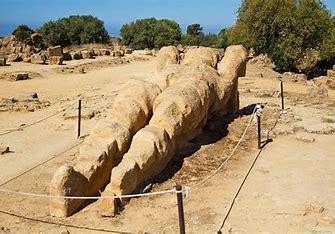
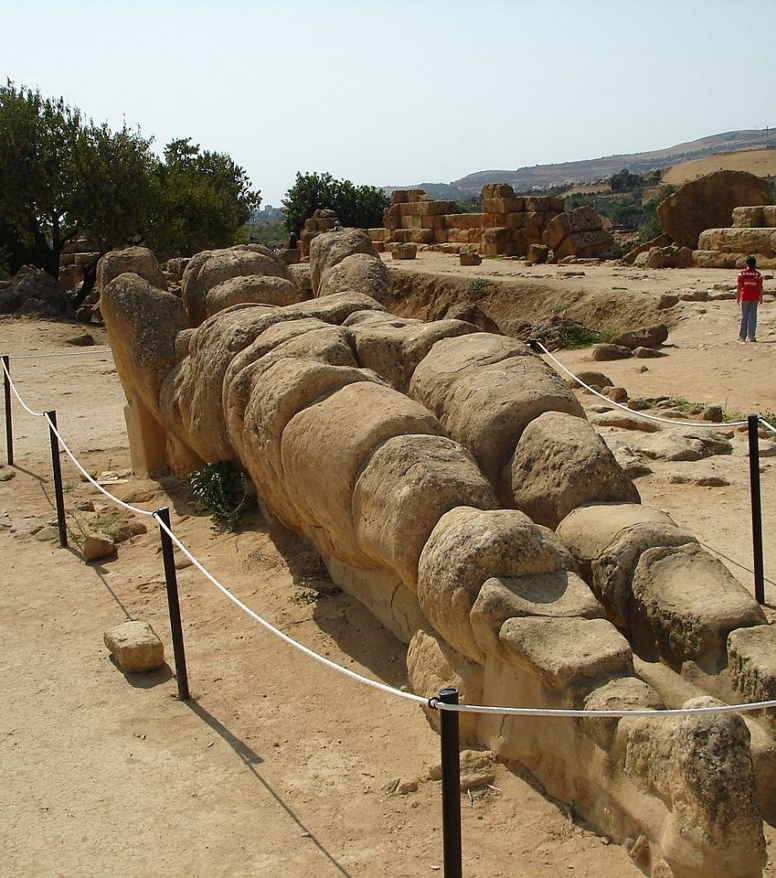
The temple was ransacked during the return of the Carthaginians in the year 406 BC, and was totally destroyed in an earthquake that affected many parts of Sicily and Italy altogether. In the 18th century, the rubble was turned into a quarry to be used to benefit the city of Agrigento. From this, they pulled many blocks to create a dam in the water.
The most recent news about this site is on February 15th, 2024, a horse sculpture was found 1,000 miles away from the shore of Agrigento. Not much is known about this prancing horse sculpture, but it is most likely coming from the dam constructed out of the blocks from the temple in the 18th century. Moreover, the sculpture most likely who have been located on the frieze.
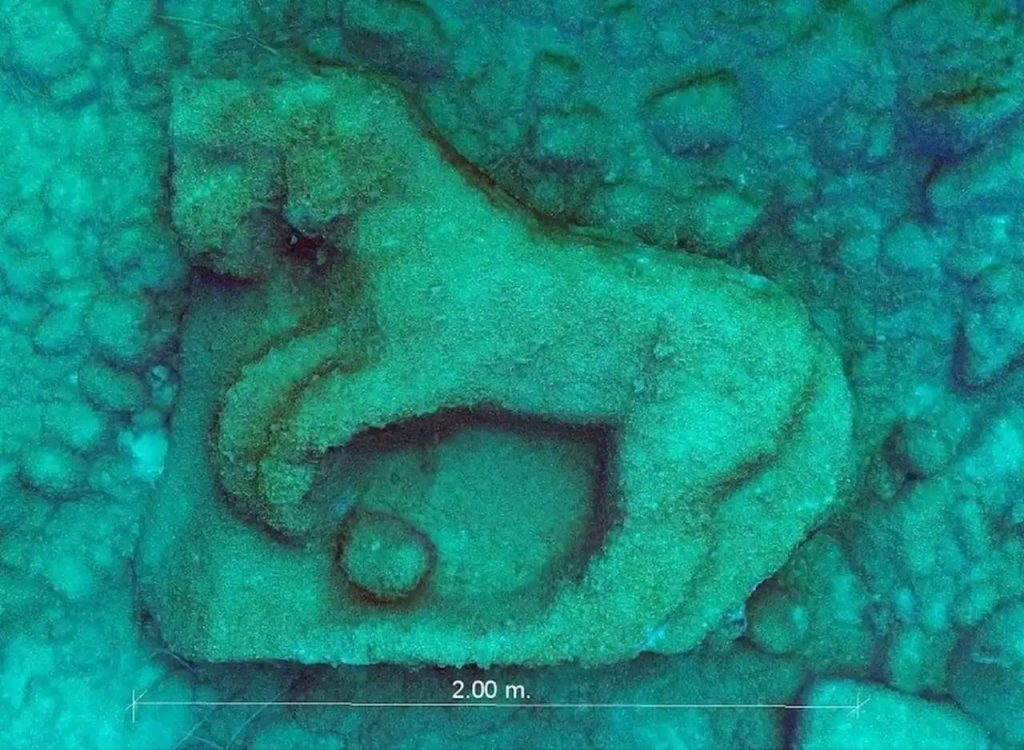
Bibliography
- Adornato, Gianfranco. 2012. “Phalaris: Literary Myth or Historical Reality? Reassessing Archaic Akragas.” American Journal of Archaeology 3: 483-506
- Agrigento (Akragas), www.brown.edu/Departments/Joukowsky_Institute/courses/greekpast/4770.html. Accessed 12 Mar. 2024.
- Asheri, David (1988). “Carthaginians and Greeks,” in Boardman, John; Hammond, N. G. L.; Lewis, D. M.; Ostwald, M. (eds.). The Cambridge Ancient History IV (2 ed.). (Cambridge: Cambridge University Press), 766–780.
- Bell, Malcolm. 1980. “Stylobate and Roof in the Olympieion at Akragas.” American Journal of Archaeology 83: 359-72
- Diodorus, Library of History 13.82
- Holloway, Ross. 2000. The Archaeology of Ancient Sicily. London: Routledge.
- “Classics and Ancient History.” Temple of Zeus Olympios, Agrigento, warwick.ac.uk/fac/arts/classics/intranets/students/modules/greekreligion/database2/clulbe/. Accessed 12 Mar. 2024.
- Marconi, Clemented 2016. “The Greek West: Temples and their Decoration”, in Margaret M. Miles, A Companion to Greek Architecture (Newark: John Wiley & Sons, Incorporated), 165-190.
- Saraceni, Jessica Esther. “Ancient Marble Sculpture from Sicily Reassessed.” Archaeology Magazine, www.archaeology.org/news/12159-240215-sicily-marble-relief. Accessed 12 Mar. 2024.
- “Theron.” Encyclopædia Britannica, Encyclopædia Britannica, inc., www.britannica.com/biography/Theron. Accessed 12 Mar. 2024.
- Thornton, Isabella. 2024. “2500 Year Old Marble Horse From Ancient Greek Temple Discovered 30 Feet Underwater.” History Enhanced.